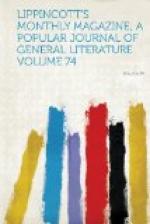[Illustration: Crystal palace—London exhibition building, 1851.]
The last of these periods comes nearest to our standard. The first had undying brilliance in certain fields, but the scope of its influence was geographically narrow, and its excessively active thought was not what we are wont to consider practically productive, its conquests in the domain of physical science being but slender. The second was in no sense originative, mankind being occupied, quietly and industriously, in making themselves comfortable in the pleasant hush after the secular rattle of spear and shield. The third was certainly full of results in art, science and the diffusion of intelligence through the upper and middle strata of society. It might well have celebrated the first centennial of the discovery of printing or of the discovery of America by assembling the fresh triumphs of European art, so wonderful to us in their decay, with the still more novel productions of Portuguese India and Spanish America. But the length of sea—voyages prosecuted in small vessels with imperfect knowledge of winds and currents, and the difficulties of land-transportation when roads were almost unknown, would have restricted the display to meagre proportions, particularly had Vienna been the site selected. Few visitors could have attended from distant countries, and the masses of the vicinage could only have stared. The idea, indeed, of getting up an exhibition to be chiefly supported by the intelligent curiosity of the bulk of the people would not have been apt to occur to any one. The political and educational condition of these was at the end of the century much what it had been at the beginning. Labor and the laborer had gained little.
The weapon-show, depicted in Old Mortality, and the market-fair, as vivid in the Vicar of Wakefield, exemplify the expositions of those days. To them were added a variety of church festivals, or “functions,” still a great feature of the life of Catholic countries. Trade and frolic divided these among themselves in infinite gradation of respective share, now the ell-wand, and now the quarter-staff or the fiddler’s bow, representing the sceptre of the Lord of Misrule. “At Christe’s Kirk on the Grene that day” the Donnybrook element would appear to have predominated. The mercantile feature was naturally preferred by gentle Goldy, and the hapless investor in green spectacles may be counted the first dissatisfied exhibitor on record at a modern exposition, for he skirts the century.
Looking eastward, we find these rallies of the people, the time-honored stalking-grounds of tale-writers and students of character generally, swell into more imposing proportions. The sea dwindles and the land broadens. Transportation and travel become difficult and hazardous. Merchant and customer, running alike a labyrinthine gauntlet of taxes, tolls and arbitrary exactions by the wolves of schloss and




